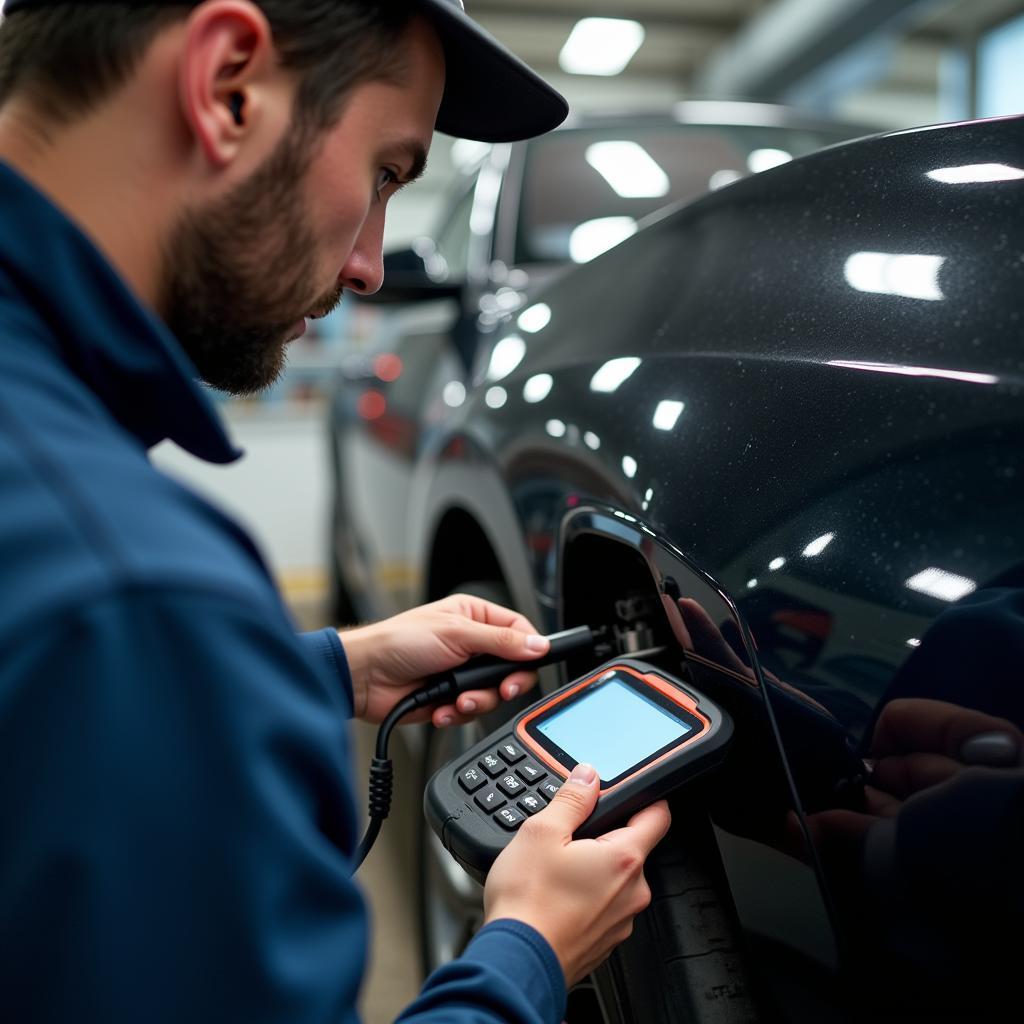Electronic Power Steering (EPS) issues can be a real headache, leaving you with a heavy steering wheel and a potentially dangerous driving situation. This guide will walk you through the common causes of EPS problems, how to diagnose them, and potential solutions to get your car back on the road safely.
Understanding Your Car’s EPS System
The EPS system in your car uses an electric motor to assist you in steering. Unlike older hydraulic systems, EPS doesn’t rely on power steering fluid, making it more efficient and requiring less maintenance. However, when problems arise, they can be tricky to pinpoint. If you’re asking “How Do I Fix The Eps Problem In My Car,” you’re likely experiencing symptoms like a stiff steering wheel, warning lights on your dashboard, or unusual noises while turning.
Similar to how to fix a slow leak in car tire, addressing the root cause is crucial for long-term solutions. Ignoring EPS problems can lead to more serious issues and costly repairs down the line. So, let’s dive into the most common culprits.
Common Causes of EPS Problems
- Low Battery Voltage: A weak battery can disrupt the power supply to the EPS system. This is often the simplest fix, so checking your battery is a good starting point when troubleshooting EPS problems.
- Faulty EPS Control Module: This module is the brain of the EPS system. If it malfunctions, it can cause a variety of problems, from intermittent steering assistance to complete system failure.
- Steering Angle Sensor Issues: This sensor tells the EPS control module the position of your steering wheel. A faulty sensor can lead to inaccurate steering assistance or even disable the system altogether.
- Wiring Problems: Damaged or corroded wiring can disrupt communication between the various components of the EPS system.
- Torque Sensor Malfunction: The torque sensor measures the force you apply to the steering wheel and tells the EPS motor how much assistance to provide. A malfunctioning torque sensor can result in inconsistent or inadequate power steering.
 EPS Control Module Diagram
EPS Control Module Diagram
Diagnosing the Problem
How do I fix the eps problem in my car without professional help? While a mechanic is best equipped for complex diagnostics, you can start by checking the basics. Examine the battery terminals for corrosion and ensure they’re securely connected. Inspect the fuses related to the EPS system. You can often find the fuse box location in your owner’s manual.
This process has similarities with how to fix a stuck window in a car, where initial checks can often save time and money. If these basic checks don’t reveal the issue, it’s time to consult a professional. They’ll have the diagnostic tools necessary to pinpoint the problem accurately.
Solutions for EPS Problems
- Battery Replacement or Recharge: If the battery is the culprit, replacing or recharging it can often solve the EPS problem.
- EPS Control Module Replacement or Repair: A faulty control module may require replacement or, in some cases, repair.
- Steering Angle Sensor Replacement: A malfunctioning steering angle sensor will need to be replaced.
- Wiring Repair or Replacement: Damaged or corroded wiring will need to be repaired or replaced.
- Torque Sensor Replacement: A faulty torque sensor typically requires replacement.
 Car EPS Wiring Diagram
Car EPS Wiring Diagram
What if the EPS light stays on?
If the EPS warning light stays on even after addressing potential issues, it’s crucial to have your car diagnosed by a qualified mechanic immediately.
Can I drive my car with an EPS problem?
Driving with a faulty EPS system can be dangerous. It can make steering significantly harder, especially at low speeds. Seek professional help as soon as possible.
 Mechanic using a diagnostic tool to troubleshoot EPS problems
Mechanic using a diagnostic tool to troubleshoot EPS problems
Seeking Professional Help
When it comes to complex electrical systems like EPS, it’s often best to seek professional assistance. Experienced mechanics have the necessary expertise and diagnostic equipment to pinpoint the issue accurately and perform the necessary repairs safely.
This scenario is similar to finding car door fixing near me, where professional help is often the best approach for complex repairs. Contact Autotippro at +1 (641) 206-8880 or visit our office at 500 N St Mary’s St, San Antonio, TX 78205, United States for expert assistance.
Conclusion
Understanding the potential causes and solutions to EPS problems can help you address this issue effectively. While some basic checks can be performed at home, seeking professional help is often the safest and most efficient way to fix your car’s EPS system and ensure your safety on the road. Remember, addressing the problem promptly can prevent further damage and costly repairs down the line. Don’t hesitate to reach out to us at AutoTipPro for any assistance with your car troubles.
FAQ
-
What does EPS stand for in a car? EPS stands for Electronic Power Steering.
-
Is it safe to drive with the EPS light on? No, it’s not recommended. Driving with a faulty EPS system can be dangerous.
-
How much does it cost to fix an EPS problem? The cost varies depending on the specific issue and the make and model of your car.
-
Can a low battery cause EPS problems? Yes, a low battery voltage can disrupt the EPS system.
-
What are the symptoms of a failing EPS system? Common symptoms include a stiff steering wheel, warning lights, and unusual noises while turning.
-
How can I prevent EPS problems? Regular car maintenance, including battery checks, can help prevent EPS issues.
-
Where can I find reliable car repair services? Autotippro offers expert car repair services, including EPS system diagnostics and repairs. Contact us for professional assistance. Similar to looking for car shops that fix dents, choosing a reputable repair shop is crucial. You can also try searching for services like cara fix 4g redmi note 3 if you have other tech related issues.




Leave a Reply